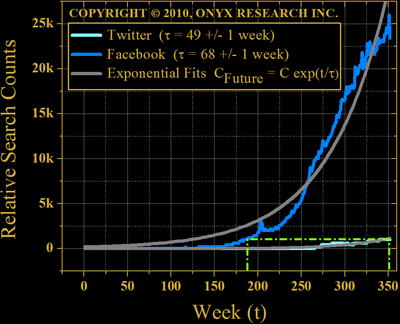_October2013_small-c5284e74ed9ef79f612813617b47061d92bf282e0f0f8ff07179efcb1aa8cc1a.jpg)
|
Research & Analysis for Business and Investment Clients |
|
Faceoff: Social Media Analysis — Who's Growing & Who's Shrinking
Twitter, Facebook, MySpace, & Google
Social media companies changed how we communicate, date, and share information. Twitter, Facebook, and MySpace are all successful brands. Strong growth and a low financial barrier-to-entry make social media an attractive and competitive space.
Google Trends data provide company keyword search numbers. Raw search data are used to gauge interest in Twitter, Facebook, MySpace, and Google. Google is included to gauge social media company interest relative to a well-known, often searched internet brand.
The only company to decline in search query volume is MySpace. Google searches including MySpace as a search term were nearly equivalent to searches including the search term Google in mid-2008 (see Figure 1).
 Figure 1. Twitter, FaceBook, Google, & MySpace relative search counts (values scaled by Twitter search count)
Figure 1. Twitter, FaceBook, Google, & MySpace relative search counts (values scaled by Twitter search count)
The world wide web giveth and taketh. While MySpace grew tremendously through 2008, on-line music could not keep the digital information fire hose from whipping in Facebook's direction. Wired discusses the business model challenges facing MySpace.
Rocketing past both Google and MySpace in mid-2009, Facebook search growth is impressive. Launched in early 2004, Facebook has eclipsed Google in search count by over three fold.
Massive data quantities necessitate quality search capabilities. Savvy companies like RockMelt seek to improve search for "Facebook Freaks". Google, no doubt, benefits from Facebook's growth, but may be unable to crawl Facebook's content. As a result, the Microsoft Bing-Facebook partnership will be a strategic battleground.

Created in mid-2006, Twitter shows strong 2010 growth. Search counts are ~15 times lower than Facebook, however, Twitter exhibits recent nonlinear search query growth. Google also records a correlated increase in search traffic in 2010 (Twitter offers an API connecting Google's search services with Tweets).
Given Google's focus on speed (Chrome Fast and Google Instant are two examples), a commonality between the two companies exists.
Comparing Facebook & Twitter
Growth Rates
Based on search count data, Facebook and Twitter are two major players in the social media space. Will Twitter grow as fast as Facebook?
Measuring growth requires a growth rate metric. An exponential model is reasonable when user number is related the rate at which additional users join (see Appendix for detail). The equation used for fitting is CFuture(t) = C exp(t/τ). Data for each company were fit to this exponential model (see Figure 2).
 Figure 2. Twitter-Facebook growth comparison. Basic exponential model assumed. Model assumes content grows nonlinearly with new adopters. Dotted green lines
define time span separating 1k relative search count equivalence (Facebook reached 1k ~187 weeks after 2005. Twitter reached the same value ~160 weeks later)
Figure 2. Twitter-Facebook growth comparison. Basic exponential model assumed. Model assumes content grows nonlinearly with new adopters. Dotted green lines
define time span separating 1k relative search count equivalence (Facebook reached 1k ~187 weeks after 2005. Twitter reached the same value ~160 weeks later)
